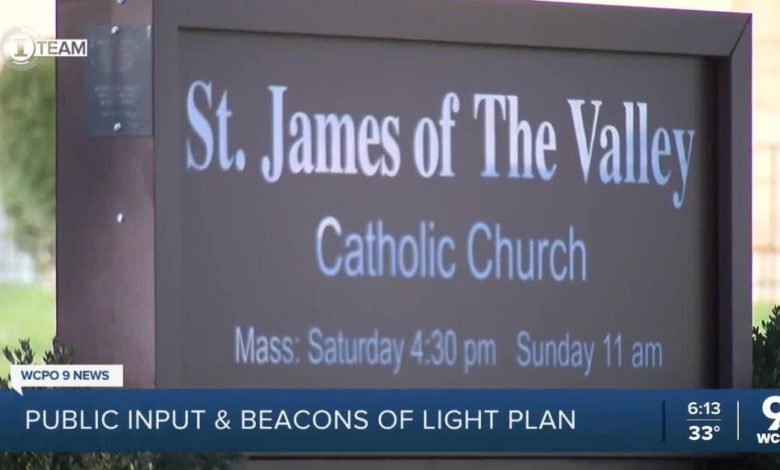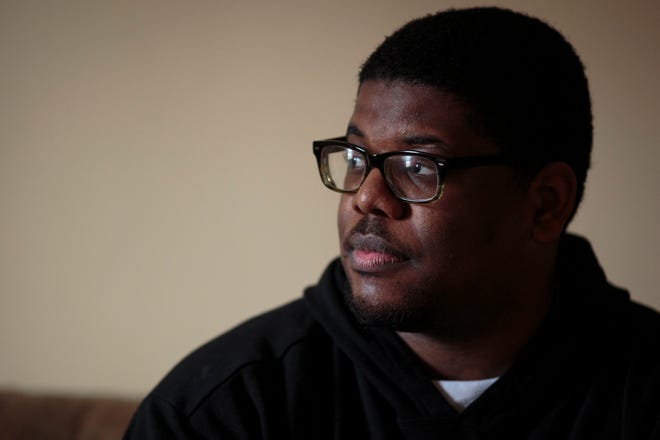
CINCINNATI — When the Archdiocese of Cincinnati invited public comment on the Beacons of Light initiative, Father Alex McCullough’s flock had a lot to say about it.
“I know for a fact that a fair number of my parishioners and a fair number of my staff gave their thoughts, as did I,” said the 33-year-old pastor of three churches in the Winton Wyoming Pastoral Region. “We were very intentional about telling them from the pulpit that this is an important step in the process, and they should let their voice be heard.”
Lot Tan
Church officials got the message loud and clear, based on the revised maps published by the Archdiocese Sunday.
The new maps corrected a problem McCullough spotted immediately when Beacons of Light was announced in October. They assigned St. James of the Valley in Wyoming to a parish family that did not include Our Lady of the Rosary in Winton Woods and St. Mathias the Apostle in Forest Park. And that could have erased seven years of hard work by those three parishes to consolidate staffs, share a school and recruit new parishioners.
“We’ve been one of the fastest-growing regions in the archdiocese over the last three years,” McCullough said. “There’s a lot of momentum, a lot of excitement.”
The new maps returned St. James to its parish partners in the Winton Wyoming Pastoral Region, while adding a fourth church – Our Lady of the Valley in Reading.
The Archdiocese received roughly 7,800 comments from local Catholics about the Beacons of Light restructuring plan, which assigned parishes to groups that will be asked to consolidate operations in the next five years. Spokeswoman Jennifer Schack said about 25% of the public comments involved “local considerations” like the St. James predicament.
“Although we had conceptually these ideas of the existing relationships, hearing it from the people that are in the parishes of their hopes for the future or success stories of how they’re working together already, those local considerations were definitely highlighted and made for some edits that are hopefully very strong for the final arrangement,” Schack said.

Lot Tan
Another example involved two churches in Milford that were split apart in the original draft but re-united in map two. St. Andrew the Apostle and St. Elizabeth Ann Seton have jointly operated a school since 1959. But the original maps assigned St. Andrew to a two-parish family with St. Columban in Loveland, while Seton was paired with St. Vincent in Mt. Carmel.
“That arrangement had a very high volume of input, people wanting that to be put back together,” Schack said.
“My parishes are mostly happy with the change,” said Father Adam Puntel, pastor of the St. Andrew - St. Elizabeth Ann Seton parish region since July 2020. “But the process of reorganization will be a complex movement of many pieces. The next five years will require change and sacrifice by all the priests and people of God they serve.”
While the public responses resolved some obvious issues, they didn’t keep the revised maps from creating new parish groupings could leave local Catholics scratching their heads and worrying about the fate of their favorite church.
Take for instance the S-12 family of parishes in southern Hamilton County. It now includes Holy Family parish in Price Hill, St. Joseph in the West End, St. Leo the Great in North Fairmount, St. Boniface in Northside and St. Therese Little Flower in Mt. Airy.
The new parish family is expected to have three priests. To reach all five parishes in a round-trip tour, those priests would have to drive 22.7 miles and spend 47 minutes in their car, assuming no traffic jams on I-75.
Little Flower is one three Catholic parishes affiliated with Our Lady of Grace regional school, which has also accepted students from St. Ann in Groesbeck, St. Margaret Mary in College Hill and the Church of the Assumption in Mt. Healthy. But it wasn’t grouped with any of those parishes in the October draft of Beacons of Light. And it has four new partners in the second draft that also don’t include its school affiliations.
Little Flower parish officials referred the I-Team’s questions to the Archdiocese. Schack said she didn’t know what factors led to the final grouping for Little Flower, but she added that geography and travel patterns were among the “local considerations” involved in the decision-making process.
For any parish unhappy with the final groupings, Schack offered little hope for new revisions.
“The Beacons of Light map is final. It will be implemented next summer,” she said. “Will there need to be local alterations? I couldn’t say. But we need a plan to get us started.”
Schack said parish families will have an opportunity to shape their own future if they can work together.
“We want more than anything for a family of parishes to pull their resources together to be growing and so ideally, none of the churches close and they’re each growing individually and we see where we’re at in five and ten years again,” Schack said. “But we need to be realistic about the resources and what we can supply.”
McCullough is convinced growth is possible with the kind of resource sharing the Beacons of Light initiative is seeking.
“There is a tendency for people to dig in their heels and say, ‘I want things to stay the same forever.’ But this is a beautiful opportunity and a great time for our church to go on offense,” he said. “Some of the folks who maybe aren’t on board at this point can see the fruit that comes from this and hopefully participate in the beauty of our mission.”









